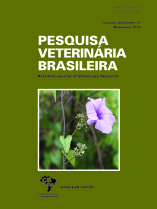 |
|
|
|
Year 2018 - Volume 38, Number 11
|

|
Lung lesions of slaughtered horses in southern Brazil, 38(11):2056-2064
|
ABSTRACT.- Bianchi M.V., Mello L.S., De Lorenzo C., Lopes B.C., Snel G.G.M., Driemeier D. & Pavarini S.P. 2018. Lung lesions of slaughtered horses in southern Brazil. [Lesões pulmonares de equinos de matadouro‑frigorífico no Sul do Brasil.] Pesquisa Veterinária Brasileira 38(11):2056-2064. Setor de Patologia Veterinária, Faculdade de Veterinária, Universidade Federal do Rio Grande do Sul, Av. Bento Gonçalves 9090, Porto Alegre, RS 91540-000, Brazil. E-mail: saulo.pavarini@ufrgs.br
Respiratory diseases cause significant veterinary costs, reduce performance and require withdrawal of horses. Yet, studies of the causes of pneumonia in horses are scant. This study aimed to describe the pathological and microbiological features of lung lesions in slaughtered horses in southern Brazil. In this study, 84 samples of lungs were examined, and a conclusive diagnosis was obtained in 74 cases. These were composed of bronchopneumonia in 50 cases, followed by granulomatous eosinophilic pneumonia (9/74), recurrent airway obstruction (7/74), lung fibrosis (4/74), lung hemorrhage (3/74) and pulmonary pythiosis (1/74). Bronchopneumonia had grossly firm focally extensive yellow to dark-red areas, which consisted microscopically of multifocal to coalescing infiltrate of degenerate neutrophils. Streptococcus equi subsp. zooepidemicus was identified in 21 of the 50 cases. Granulomatous eosinophilic pneumonia had multifocal pinpoint firm-hard yellow areas, which microscopically were composed of granulomas with a mineralized center surrounded by collagen fibers and severe infiltrate of eosinophils. Recurrent airway obstruction had mild multifocal pinpoint firm white areas that consisted microscopically of large amounts of mucus inside bronchi and bronchiole. Lung fibrosis had two patterns: focally extensive areas of consolidation and firm nodular areas. Microscopically, the first pattern had interstitial to peribronchial fibrosis, while the second had, in addition to the interstitial fibrosis, a severe pneumocyte hyperplasia and an alveolar infiltrate of neutrophils and macrophages with rare intranuclear inclusion bodies (equine herpesvirus 5, EHV-5). Pulmonary pythiosis presented a focal firm nodular area, with multiple kunkers observed in the cut surface, which corresponded microscopically to areas of necrosis surrounded by a mixed inflammatory infiltrate. At the periphery of the necrotic areas, multiple negatively stained hyphae were observed, which were evidenced through Grocott’s stain and immunohistochemistry anti-Pythium insidiosum. |
| |
|
|
| |
|
 |